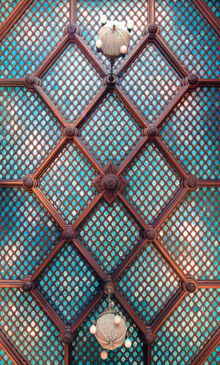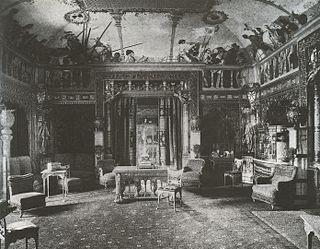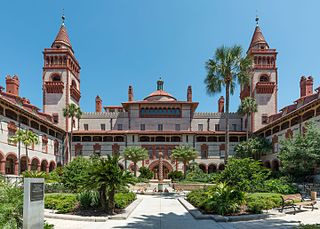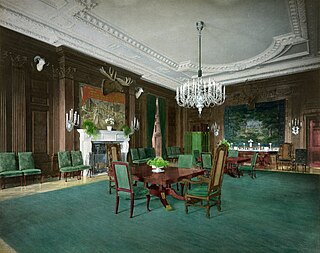
Pottier & Stymus was a prominent American furniture and design firm of the Victorian period.

Pottier & Stymus was a prominent American furniture and design firm of the Victorian period.
August Pottier, an immigrant from France, and William P. Stymus Sr. opened the company in New York City in 1859. Their workshop was on 115 Wooster Street, and their salesroom was at 623 Broadway. [1] The company grew quickly, and by 1871 the firm's factory occupied a full block on Lexington Avenue and 42nd Street, on the present site of the Socony–Mobil Building. By 1872, they employed 700 men and 50 women. Pottier & Stymus made furniture in the Neo-Greco, Renaissance Revival, Egyptian Revival, and Modern Gothic Styles. [2] Three drawing published in Harper's New Monthly Magazine in November 1876 provide evidence that in addition to exclusive furniture for office buildings and rich clients, Pottier & Stymus also produced simpler and cheaper furniture. [1] Some of Pottier & Stymus' work can be seen at the Brooklyn Museum.


From the Golden Book of Celebrated Manufacturers and Merchants published on the occasion of the Centennial Exhibition in Philadelphia, it is known that Pottier & Stymus used a detailed system of documentation for their products. From the beginning of the construction process, each piece of furniture was assigned a multi-digit number, and pieces which belonged together were given sequential numbers. Few objects were clearly marked making definitive identification difficult, but when marked, Pottier & Stymus used one of three methods: pencil, impressions or stencil in black ink. [1]

The Eastlake movement was a nineteenth-century architectural and household design reform movement started by British architect and writer Charles Eastlake (1836–1906). The movement is generally considered part of the late Victorian period in terms of broad antique furniture designations. In architecture the Eastlake style or Eastlake architecture is part of the Queen Anne style of Victorian architecture.

An antique is an item perceived as having value because of its aesthetic or historical significance, and often defined as at least 100 years old, although the term is often used loosely to describe any object that is old. An antique is usually an item that is collected or desirable because of its age, beauty, rarity, condition, utility, personal emotional connection, and/or other unique features. It is an object that represents a previous era or time period in human history. Vintage and collectible are used to describe items that are old, but do not meet the 100-year criterion.

Carrère and Hastings, the firm of John Merven Carrère and Thomas Hastings, was one of the outstanding American Beaux-Arts architecture firms. Located in New York City, the firm practiced from 1885 until 1929, although Carrère died in an automobile accident in 1911.

The Lightner Museum is a museum of antiques, mostly American Gilded Age pieces, housed within the historic Hotel Alcazar building in downtown St. Augustine. This 1887 Spanish Renaissance Revival style building is listed on the National Register of Historic Places.

Thomas Edison National Historical Park preserves Thomas Edison's laboratory and residence, Glenmont, in West Orange, New Jersey, United States. These were designed, in 1887, by architect Henry Hudson Holly. The Edison laboratories operated for more than 40 years. Out of the West Orange laboratories came the motion picture camera, improved phonographs, sound recordings, silent and sound movies and the nickel-iron alkaline electric storage battery.

Llewellyn Park is a historic gated community and census-designated place (CDP) located within West Orange in Essex County, in the U.S. state of New Jersey. Llewellyn Park is thought to be the country's first planned residential community, and the site of the first large-scale naturalization of crocus, narcissus, and jonquils. The community features 175 homes on 425 acres (172 ha) and is located 12 miles (19 km) west of New York City.

Chateau-sur-Mer is one of the first grand Bellevue Avenue mansions of the Gilded Age in Newport, Rhode Island. Located at 474 Bellevue Avenue, it is now owned by the Preservation Society of Newport County and is open to the public as a museum. Chateau-sur-Mer's grand scale and lavish parties ushered in the Gilded Age of Newport, as it was the most palatial residence in Newport until the Vanderbilt houses in the 1890s. It was designated a National Historic Landmark in 2006.

The firm of Herter Brothers,, was founded by German immigrants Gustave (1830–1898) and Christian Herter (1839–1883) in New York City. It began as a furniture and upholstery shop/warehouse, but after the Civil War became one of the first American firms to provide complete interior decoration services. With their own design office and cabinet-making and upholstery workshops, Herter Brothers could provide every aspect of interior furnishing—including decorative paneling, mantels, wall and ceiling decoration, patterned floors, carpets and draperies.

Whitehall is a 75-room, 100,000 square foot Gilded Age mansion open to the public in Palm Beach, Florida in the United States. Completed in 1902, it is a major example of neoclassical Beaux Arts architecture designed by Carrère and Hastings for Henry Flagler, a leading captain of industry in the late 19th century, and a leading developer of Florida as a tourist destination. The building is listed a National Historic Landmark. It now houses the Henry Morrison Flagler Museum, named after its builder.

The Hotel Ponce de Leon, also known as The Ponce, was a luxury hotel in St. Augustine, Florida, built by millionaire developer and Standard Oil co-founder Henry M. Flagler. Built between 1885-1887, the winter resort opened in January 1888. The hotel was designed in the Spanish Renaissance Revival style as the first major project of the New York architecture firm Carrère & Hastings, which gained world renown for more than 600 projects, including the House and Senate Office Buildings flanking the US Capitol. Their final project was the New York Public Library.

Glensheen, the Historic Congdon Estate is a 20,000 square foot mansion in Duluth, Minnesota, United States, operated by the University of Minnesota Duluth as a historic house museum. Glensheen sits on 12 acres of waterfront property on Lake Superior, has 39 rooms and is built in the Jacobean architectural tradition, inspired by the Beaux-Arts styles of the era. The mansion was constructed as the family home of Chester Adgate Congdon. The building was designed by Minnesota architect Clarence H. Johnston Sr., with interiors designed by William A. French Co. and the formal terraced garden and English style landscape designed by the Charles Wellford Leavitt firm out of New York. Construction began in 1905 and was completed in 1908. The home cost a total of $854,000, equivalent to more than $22 million in 2017. The home is a crowning example of design and craftmanship of the Midwestern United States in the early 20th century.

Ayers House is the present-day name for a historic mansion on North Terrace, Adelaide, South Australia. It is named after Sir Henry Ayers, five times Premier of South Australia and wealthy industrialist, who occupied it from 1855 until 1897. It is the only mansion on North Terrace to have survived. The house has been listed on the South Australian Heritage Register since July 1980.

Millford Plantation is a historic farmstead and plantation house located on SC 261 west of Pinewood, South Carolina. It was sometimes called Manning's Folly, because of its remote location in the High Hills of Santee section of the state and its elaborate details. Designated as a National Historic Landmark, it is regarded as one of the finest examples of Greek Revival residential architecture in the United States. The house has been restored and preserved along with many of its original Duncan Phyfe furnishings.

The Roberson Mansion, part of the Roberson Museum and Science Center, is a home in Binghamton, New York. It is an Italian Renaissance style house, designed by Binghamton architect C. Edward Vosbury and built in 1904, and completed in 1907, for Alonzo Roberson Jr. and his wife Margaret Hays Roberson. It was built with all of the then modern conveniences: an elevator, central heat, combination gas and electric lighting, a dumb waiter, an intercom system, and a private bath for each bedroom.

Daniel Pabst was a German-born American cabinetmaker of the Victorian Era. He is credited with some of the most extraordinary custom interiors and hand-crafted furniture in the United States. Sometimes working in collaboration with architect Frank Furness (1839–1912), he made pieces in the Renaissance Revival, Neo-Grec, Modern Gothic, and Colonial Revival styles. Examples of his work are in the collections of the Metropolitan Museum of Art, the Philadelphia Museum of Art, the Art Institute of Chicago, and the Victoria and Albert Museum in London.

Kimbel & Cabus was a Victorian-era furniture and decorative arts firm based in New York City. The partnership was formed in 1862 between German-born cabinetmaker Anthony Kimbel and French-born cabinetmaker Joseph Cabus (1824–1894). The company was noted for its Modern Gothic and Anglo-Japanese style furniture, which it popularized at the 1876 Centennial Exposition.

A. H. Davenport and Company was a late 19th-century, early 20th-century American furniture manufacturer, cabinetmaker, and interior decoration firm. Based in Cambridge, Massachusetts, it sold luxury items at its showrooms in Boston and New York City, and produced furniture and interiors for many notable buildings, including The White House. The word "davenport," meaning a boxy sofa or sleeper-sofa, comes from the company.

Modern Gothic, also known as Reformed Gothic, was an Aesthetic Movement style of the 1860s and 1870s in architecture, furniture and decorative arts, that was popular in Great Britain and the United States. A rebellion against the excessive ornament of Second Empire and Rococo Revival furniture, it advocated simplicity and honesty of construction, and ornament derived from nature. Unlike the Gothic Revival, it sought not to copy Gothic designs, but to adapt them abstract them, and apply them to new forms.

The Moody Mansion, also known as the Willis-Moody Mansion, is a historic residential building in Galveston, Texas located at 2618 Broadway Avenue. The thirty-one room Romanesque mansion was completed in 1895. The home is named for William Lewis Moody, Jr., an American financier and entrepreneur in the cotton business who bought the home from Galveston socialite Narcissa Willis. The mansion was added to the National Register of Historic Places on May 13, 1994. Tours are offered, and the facilities can be rented out for weddings and other events.
Henry Hudson Holly (1832-1892) was an American architect who, in his generation, was one of the best-known architects with a practice spanning the entire United States. He is probably best remembered as the author of three architectural books. "Holly's country seats: containing lithographic designs for cottages, villas, mansions, etc., with their accompanying outbuildings; also, country churches, city buildings, railway stations, etc., etc" which was published in 1863 by D. Appleton and Co. of New York and is a pattern book of standard primarily Italianate residential designs. In 1871 he published "Church Architecture. Illustrated with Thirty-Five Lithographic Plates, from Original Designs". In 1878 he published "Modern Dwellings in Town and Country Adapted to American Wants and Climate, with a Treatise on Furniture and Decoration" by Harper and Brothers of New York. It served to introduce the domestic Queen Anne Revival style to America. Both the Country Seats and the Modern Dwellings books were subsequently combined and reprinted as "Holly's Country Seats and Modern Dwellings" in 1977 by the American Life Foundation Library of Victorian Culture. The Church Architecture book has also subsequently been reprinted by at least two modern publishers - Wentworth Press on August 25, 2016 and Forgotten Books on July 19, 2017.